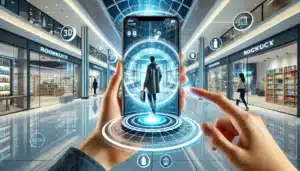In an era where consumers are inundated with advertisements, businesses are constantly seeking innovative ways to capture attention and engage their audiences. Augmented reality (AR) marketing has emerged as a compelling solution, offering immersive experiences that blend digital elements with the real world. This article explores the benefits of augmented reality in marketing, showcases successful campaigns, examines the technology behind AR advertising, discusses the challenges brands face, and anticipates the future of this transformative tool.
What are the Benefits of Augmented Reality in Marketing?
How does augmented reality improve customer engagement?
One of the primary benefits of augmented reality marketing is its ability to significantly enhance customer engagement. By providing an immersive experience, AR enables consumers to interact with products in a way that traditional marketing methods simply cannot match. For instance, AR applications can allow customers to visualize how furniture would look in their living rooms or how a piece of jewelry would appear on them before making a purchase. This interaction fosters a deeper connection between the consumer and the brand, as they feel more involved in the shopping experience. As customers engage with AR content, they are more likely to share their experiences on social media, further amplifying the brand’s reach.

What advantages does AR marketing offer over traditional advertising?
The emergence of AR marketing has brought several benefits over traditional means of advertisement. Unlike modern methods, traditional marketing uses still images and videos, which can be quite difficult to get the attention of viewers who are bombarded with advertisements. On the other hand, augmented reality advertising is capable of producing interactive experiences that actively engage users. For instance, while standard advertisements may showcase products, AR campaigns could employ hyper-realistic simulations, permitting prospective buyers to engage with the product and hence, making the entire experience memorable. This changes the way people remember brands and increases the chances of sales, since products that customers have interacted with are more likely to be bought.
Can augmented reality increase conversion rates?
It goes without saying that integrating augmented reality in marketing strategies aids in increasing conversion rates. By allowing the integration of products into consumers’ surroundings, AR helps alleviate the doubt and apprehension that comes with online shopping. This is particularly common in the fashion and home furnishing industries, where the availability of visuals can enhance the likelihood of purchase. Customers are more likely to respond positively to AR experiences and interact with products due to gaining confidence in their decisions through digital interactions prior to purchasing, increasing conversion rates.
What are Some Successful Examples of Augmented Reality Marketing Campaigns?
Which brands have effectively used augmented reality in their advertising?
Many brands have successfully implemented augmented reality marketing campaigns, showcasing the versatility of AR technology. For instance, IKEA’s AR app allows customers to visualize furniture in their homes, thereby enhancing the shopping experience. Another notable example is L’Oreal, which introduced an AR app that enables users to virtually try on makeup. These campaigns not only engage consumers but also drive sales by allowing customers to make informed decisions. Other brands, such as Nike and Pepsi, have also leveraged AR to create unique and memorable marketing experiences, emphasizing the impact of digital content in enhancing brand perception.
What lessons can be learned from successful AR marketing campaigns?
Successful AR marketing campaigns teach valuable lessons about the importance of user experience and interactivity. Brands should focus on creating seamless and intuitive AR experiences that enhance consumer engagement. Additionally, integrating AR with social media platforms can amplify reach and encourage sharing, further driving brand awareness. Furthermore, it’s crucial for marketers to understand their target audience and tailor AR content to meet their preferences and behaviors. Authenticity and relevance are key; AR campaigns should feel organic and align with the brand’s overall messaging to resonate effectively with consumers.
How have AR experiences transformed customer interactions?
Augmented reality experiences have transformed customer interactions by bridging the gap between digital content and the real world. This transformation allows consumers to engage with brands in ways that were previously unimaginable. Instead of passively receiving information through traditional advertising, consumers can actively participate in their shopping journey. This shift has led to a more personalized experience, as brands can utilize data from AR interactions to tailor future marketing efforts. The immersive nature of AR not only enriches the customer experience but also fosters loyalty, as consumers are more likely to return to brands that offer innovative and engaging shopping experiences.
How is Augmented Reality Technology Used in Advertising?
What types of AR technology are commonly used in marketing?
Various types of AR technology are employed in marketing to create engaging and immersive experiences. Marker-based AR uses specific visual markers, such as QR codes, to trigger digital content when scanned. Markerless AR, on the other hand, relies on GPS and sensors to overlay digital elements in real-world environments without the need for specific markers. Location-based AR enhances user experiences by providing relevant content based on the user’s geographical location. Additionally, projection-based AR allows brands to project digital images onto real-world surfaces, creating interactive experiences that captivate audiences. Each type of AR technology serves a unique purpose, allowing marketers to choose the best approach for their campaigns.
How can marketers utilize AR for immersive experiences?
Marketers can utilize augmented reality technology to create immersive experiences that resonate with consumers on a deeper level. By integrating AR elements into advertising campaigns, brands can enhance storytelling and foster an emotional connection with their audience. For example, an AR app can allow users to experience a virtual tour of a destination, showcasing the brand’s offerings in an engaging way. Furthermore, interactive elements, such as games or quizzes, can be embedded within AR experiences to maintain consumer interest while promoting products. By leveraging the power of augmented reality, marketers can create memorable interactions that stand out in a competitive landscape.
What role do QR codes play in augmented reality advertising?
QR codes play a pivotal role in augmented reality advertising by facilitating easy access to AR experiences. By scanning a QR code, consumers can instantly unlock immersive content, making it a seamless addition to traditional marketing materials. This approach not only enhances engagement but also simplifies the user journey, as customers can quickly transition from discovering an advertisement to experiencing the brand’s AR content. As mobile device usage continues to rise, incorporating QR codes into AR campaigns has become increasingly effective, offering a bridge between physical and digital interactions.
What are the Challenges of Implementing Augmented Reality in Marketing?
What obstacles do marketers face when adopting AR technology?
Despite the promising benefits of augmented reality in marketing, several challenges hinder its widespread adoption. One significant obstacle is the high cost associated with developing AR applications and campaigns. Brands may struggle to justify the investment, especially smaller businesses with limited budgets. Additionally, there is a steep learning curve for marketers who are unfamiliar with AR technology, requiring time and resources to understand its applications effectively. Moreover, ensuring that AR experiences are user-friendly and accessible across various devices poses another challenge that marketers must address to maximize engagement.
How can brands overcome the challenges of AR marketing?
Brands can overcome the challenges of augmented reality marketing by adopting a strategic approach. Collaborating with specialized AR developers can help mitigate development costs and ensure high-quality experiences. Investing in user experience design is crucial to create intuitive and engaging AR applications that resonate with consumers. Furthermore, marketers should focus on educating themselves and their teams about AR technology to enhance their skill sets and improve campaign effectiveness. By leveraging partnerships and continuously learning, brands can successfully navigate the complexities of AR marketing.
What are the limitations of current augmented reality applications?
Current augmented reality applications do have limitations that brands must consider. One major limitation is the reliance on technology, as not all consumers have access to devices that support AR experiences. This can create barriers to engagement, particularly among older demographics or those in regions with limited technological infrastructure. External factors like lighting and the user environment can directly impact the effectiveness and quality of AR experiences. Brands must carefully design their AR campaigns to account for these limitations, ensuring a positive and accessible experience for all consumers.
What is the Future of Augmented Reality in Marketing?
How will AR technology evolve in the coming years?
The future of augmented reality in marketing promises exciting developments as technology continues to evolve. As AR hardware becomes more sophisticated and accessible, brands will have greater opportunities to create immersive experiences. Innovations in AR technology, such as improved tracking capabilities and enhanced graphics, will enable marketers to design more engaging campaigns. Furthermore, the integration of artificial intelligence and machine learning will allow for personalized AR experiences, tailoring content to individual preferences and behaviors, thus enhancing customer interaction.
What trends are emerging in augmented and virtual reality marketing?
Emerging trends in augmented and virtual reality marketing signal a shift towards more interactive and engaging consumer experiences. Brands are increasingly exploring the integration of AR with social media platforms, allowing users to share their interactions and promote brand visibility. Additionally, the rise of AR shopping experiences is transforming the retail landscape, as consumers seek convenience and personalized recommendations. The blending of augmented reality with gamification elements is also gaining traction, encouraging engagement through playful interactions and rewarding experiences that resonate with consumers.
How can businesses prepare for the future of AR in advertising?
To prepare for the future of augmented reality in advertising, businesses must stay informed about advancements in AR technology and consumer preferences. Investing in research and development will be crucial for brands looking to incorporate AR into their marketing strategies effectively. Additionally, fostering a culture of creativity and innovation within marketing teams will encourage the exploration of new applications and ideas. By embracing AR technology and adapting to changing consumer behaviors, businesses can position themselves at the forefront of the digital marketing landscape and create immersive brand experiences that captivate their audiences.
Conclusion
The use of augmented reality in marketing is transforming the way customers engage with brands by providing fun, interactive brand experiences. Even though problems like expense and lack of availability continue hindering accessibility, the evolution of technology is making AR an incredibly valuable asset for businesses. As organizations develop and apply AR tactics, they are able to provide unmatched, compelling marketing engagements that capture the imagination of customers and increase conversion rates. The innovative frontier of marketing focuses on creativity, and AR is leading the way with brand interaction towards more profound engagement.



